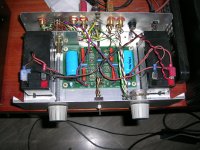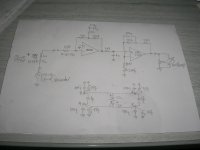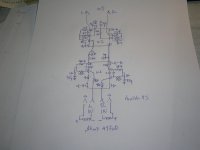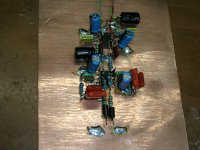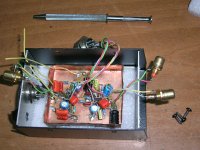Sadly can't afford trophy car due to trophy wife 🙂 (only kidding).
I think I have made my point. I put up what is a very different take on a phono stage and barely an eyebrow raised. The old guard are stuck in their ways (some luckily don't act their age, so there is hope outside this thread 🙂).
Right time to go somewhere productive...
I think I have made my point. I put up what is a very different take on a phono stage and barely an eyebrow raised. The old guard are stuck in their ways (some luckily don't act their age, so there is hope outside this thread 🙂).
Right time to go somewhere productive...
It is possible to make a pretty good RIAA preamp cheap if you limit yourself to an inexpensive MM cartridge, you know Grado, Ortofon, etc.
Just build an unbalanced input phono stage from the schematics provided by National (now TI) and others using a dual IC per stage like a LM3563.
I make a similar design for Parasound, but we added so many features that the dealers (customers) wanted that it became much more expensive than it started out to be. In fact, we are now making a cheaper model with a cheaper case, without significantly changing the internal parts, but it will still be more than you (Bill) will appreciate, because we are still making it MC usable, by using 3 IC's channel and a serious power supply, etc., but if you forgo MC it can be a quite cost effective approach.
Just build an unbalanced input phono stage from the schematics provided by National (now TI) and others using a dual IC per stage like a LM3563.
I make a similar design for Parasound, but we added so many features that the dealers (customers) wanted that it became much more expensive than it started out to be. In fact, we are now making a cheaper model with a cheaper case, without significantly changing the internal parts, but it will still be more than you (Bill) will appreciate, because we are still making it MC usable, by using 3 IC's channel and a serious power supply, etc., but if you forgo MC it can be a quite cost effective approach.
... Just build an unbalanced input phono stage from the schematics provided by National (now TI) and others using a dual IC per stage like a LM3563.
John, do you mean (LM4562) perhaps? There does not exist an IC named "LM3563".
but it will still be more than you (Bill) will appreciate, because we are still making it MC usable, by using 3 IC's channel and a serious power supply, etc., but if you forgo MC it can be a quite cost effective approach.
I would rather have dedicated MC stage as I have a dedicated turntable for MC. Less compromise. But you see rather than look at the schematic I posted and considering transimpedance for its merits in this application you would rather insult me! That makes you no better than those you complain about. This appears to be a thread full of pots. My point made once again.
Wow, Bill! I was being polite in not addressing your schematic. It is too narrow for general use.
by using 3 IC's channel and a serious power supply, etc., but if you forgo MC it can be a quite cost effective approach.
The Hagerman Bugle kit is a cost affordable preamplifier for diyers along these lines (MM or MC by adjusting it’s gain) .
http://www.hagtech.com/pdf/bugle2schema.pdf
Phono – Hagerman Audio Labs
The old Bugle 1 has served me well for many years.
George has been running the single ended version for a couple of months now.
Lucky’s single ended Aurak is as simple and as good as it can .
I have adjusted it for the Shure M97xE cartridge and performs very well ( in my ears, it outperforms the Bugle 1).
mechanical resonance in MMs
mechanical resonance in MMs
George
Attachments
How does CA car culture compare to British car culture? I always had images of flegmatic Brits fiddling with their Austin Healeys and Morgans. Disclamer: I am one of the few people here that consider cars as transportation means 😉
Here is Blowtorch Car
Attachments
Lucky’s single ended Aurak is as simple and as good as it can .
The equation for the 420R input resistor (3L-2Rc) cannot be correct, because the units are not consistent.
Last edited:
Wow, Bill! I was being polite in not addressing your schematic. It is too narrow for general use.
You've told me my system is no good and only today that an MC stage would be wasted on me so why hold back all of a sudden 😛. It's not 'my schematic' anyway, its a joint effort of cleverer than me types.
But you did say
I hope we can go forward and discuss more constructive things, even if they are sometimes controversial[\quote]. So lets discuss why this is too narrow for use. I've dropped 'general' as this is not a commercial product, but seems applicable across a wide range of MM and MI and gazillions of those are sold each year. I would hazard shure sell more M97 each year than the whole high end MC industry. So plenty of people could DIY this. The question is does the concept have merits?
After all, when discussing how to move the game on we should not care how popular something might be, but whether it is actually better or not?
The equation for the 420R input resistor (3L-2Rc) cannot be correct, because the units are not consistent.
For most carts 2L-R is used. Yes it's not dimensionally consistent as there is constant of 993 dropped out. But as fc=R/(2.pi.L) and you are solving to always have Fc at 316Hz you can see where it comes from.
3L-2R is for those annoying cartridges that won't play ball.
Shure? I haven't used one for the last 47 years. While the later Shure cartridges might work with your circuit, I think that older Shure cartridges might be peaky in the high frequency by the removal of the passive electrical roll-off designed in the cartridge (47K, 0.5-1H, 100-400pf) that complements the relatively undamped mechanical resonance in these MM cartridges.
What do you use to verify the actual frequency response of your record playback system? Do you have a test record? What do you recommend to other people?
What do you use to verify the actual frequency response of your record playback system? Do you have a test record? What do you recommend to other people?
For most carts 2L-R is used. Yes it's not dimensionally consistent as there is constant
of 993 dropped out. But as fc=R/(2.pi.L) and you are solving to always have Fc at 316Hz.
So the "3" factor is actually "3x993 Ohms/Henry" instead, when the L is in Henrys?
Usually I pick parts for RIAA to 0.1%, so want to avoid a 0.7% error in calculating.
Last edited:
So the "3" factor is actually "3x993 Ohms/Henry" instead, when the L is in Henrys?
Usually I pick parts for RIAA to 0.1%, so want to avoid a 0.7% error in calculating.
The 3 is a 2 except is edge cases. Not sure where your 0.7% comes from?
The 3 is a 2 except is edge cases. Not sure where your 0.7% comes from?
Rounding the 993 to 1000.
This mechanical resonance is proving remarkably elusive to find in an actual modern production cartridge, but we keep looking. A lot of old wives tales seem to abound.Shure? I haven't used one for the last 47 years. While the later Shure cartridges might work with your circuit, I think that older Shure cartridges might be peaky in the high frequency by the removal of the passive electrical roll-off designed in the cartridge (47K, 0.5-1H, 100-400pf) that complements the relatively undamped mechanical resonance in these MM cartridges.
I have several, but I do need the latest ortofon as that has a sweep to 50kHz. Sadly the golden era test records are just too expensive for me now.What do you use to verify the actual frequency response of your record playback system? Do you have a test record?
Nothing yet, as this is still a research project. George has characterised the M97xE pretty well but we need more data. Real measured data. With luck we might even re-discover some things that have been forgotten or buried over time.What do you recommend to other people?
Rounding the 993 to 1000.
Ah I see, no that was my memory failing me on the turnover frequency chosen. Serves me right for not checking my notes. Although TBH a 2Hz change 3dB point down in the modal zone for most listening rooms isn't a whole hill of beans.
So you are saying high end should be fearsomely expensive, cost a fortune to run, be horribly unreliable and not as good as other ways of doing it? Yeah that seems to match the way that the industry has gone.
You could add that to what I did say. It always cost a lot to do the best in every way.
-RM
- Status
- Not open for further replies.
- Home
- Member Areas
- The Lounge
- John Curl's Blowtorch preamplifier part II
